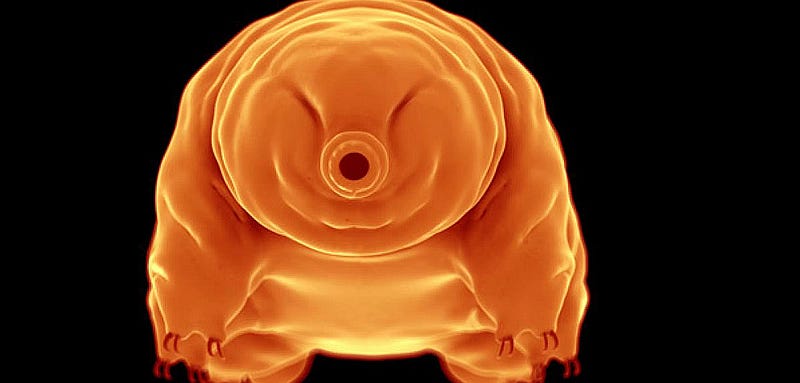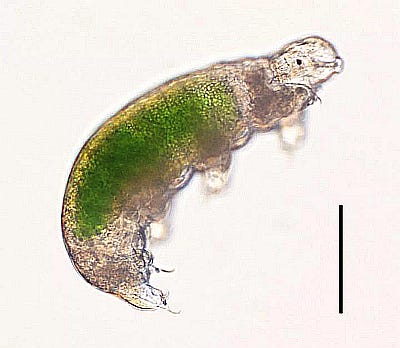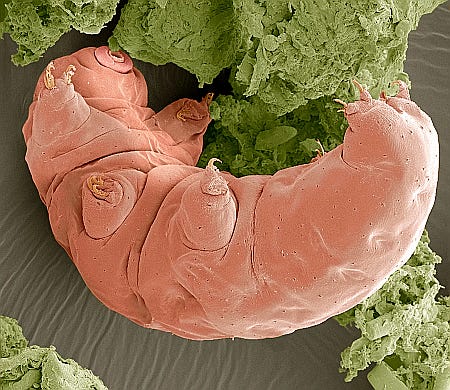# Tardigrades: Earth’s Resilient Explorers on the Moon?
Written on
Chapter 1: Introduction to Tardigrades
Tardigrades, affectionately dubbed water bears, are among the most recognized micro-animals due to their peculiar characteristics. Measuring roughly a millimeter in length, these resilient organisms are capable of enduring extreme environments, including the vacuum of space. Recent events suggest that thousands of these tiny beings might now be residing on the Moon.
When the Beresheet spacecraft, managed by the Israeli company SpaceIL, crashed into the Moon on April 11, it is believed that this incident may have scattered live tardigrades across the lunar landscape.

Nova Spivack, the founder of the Arch Mission Foundation, recounted, “For the first 24 hours we were just in shock. We sort of expected that it would be successful. We knew there were risks but we didn’t think the risks were that significant.” His organization was responsible for designing the tardigrade payload.
The robotic lander housed thousands of tardigrades, along with human DNA, sealed in resin between layers of nickel—similar to how insects are preserved in amber. The tape securing this biological time capsule was also embedded with countless tardigrades. While it remains unclear whether these creatures survived the crash, their extraordinary resilience gives them a fighting chance.
Section 1.1: The Habitat of Tardigrades
Typically, these organisms thrive in diverse environments, favoring moist habitats such as moss beds and sediment found in lakes. Remarkably, tardigrades are the only known life forms that can withstand the harshness of space.
Often referred to as water bears or moss piglets, these hardy creatures can endure temperatures ranging from -200°C (-328°F) to 150°C (300°F). They withstand pressures far beyond the deepest ocean depths and show remarkable resistance to radiation and boiling liquids. In one experiment, tardigrades were subjected to low Earth orbit conditions for 10 days and emerged unscathed.
Tardigrades can enter a state known as "tun," where they lose moisture, retract their limbs, and curl into a protective ball, allowing them to survive for over a decade without water.
“I wish I were a waterbear — Then I’d be comfy anywhere
In a vacuum, boiled or frozen — Centuries of happy dozing
Pressure never leaves you in despair, when you’re a waterbear”
— Mal Webb
Their minuscule bodies, measuring between 0.5 and 1.2 mm (0.02 to 0.05 inches), are characterized by eight legs and tiny appendages extending from their plump bodies. Tardigrades belong to a unique phylum, encompassing around 1,000 known species, which is significantly less than the over 60,000 species found in the phylum Chordata, to which humans belong.

Chapter 2: Resilience Through Time
Tardigrades have inhabited Earth for an astonishing 500 million years. They hatch as miniature adults and grow by molting their exoskeletons over time.
In an extraordinary experiment, a pair of tardigrades preserved in a freezer for over 30 years were thawed and rehydrated. Within just a day, one of them was stretching its legs after its lengthy slumber. Remarkably, after three weeks, this creature laid 19 eggs, with 14 successfully hatching.
A 2017 study explored how various species would cope with catastrophic extinction events, including asteroid impacts and supernova explosions. Surprisingly, even the demise of the Sun might not be enough to eliminate these resilient organisms. The study concluded, “Surprisingly we find that although human life is somewhat fragile to nearby events, the resilience of Ecdysozoa such as Milnesium tardigradum renders global sterilisation an unlikely event.”

One research paper in the journal Cell Biology from 2016 suggested that tardigrades might essentially be described as a head with four pairs of legs.
With NASA's Starlight program, tardigrades might be propelled into space at near-light speeds, as it aims to launch wafer-sized payloads using lasers.
Section 2.1: The Beresheet Mission’s Impact
The Beresheet mission, which launched on February 21, experienced a crash during its landing attempt on April 11. Since 1959, space agencies have intentionally or unintentionally crashed spacecraft onto the lunar surface, but this incident marked the first accidental crash on the Moon since 1971.

Additionally, the lander carried a time capsule containing 30 million digitized pages documenting human civilization.
Developed by the Arch Mission Foundation, this DVD-sized capsule aims to serve as a backup of Earth's knowledge. Their mission is to create archives of human history that could endure for millions, if not billions, of years throughout the Solar System.
To ensure the longevity of the 30 million pages, high-resolution nano-scale images were etched into a glass matrix, which was then coated with nickel atom by atom.
The Arch Mission Foundation also plans to encode the entire English-language Wikipedia content into synthetic DNA, with plans to send this data to the Moon via Astrobotic.
“Our job, as the hard backup of this planet, is to make sure that we protect our heritage — both our knowledge and our biology. We have to sort of plan for the worst,” Spivak expressed.

Preliminary investigations into the spacecraft's impact suggest that the tardigrades may have survived the crash. The design of their protective disk likely enhanced their chances of survival, and even if the disk broke, it’s possible that much of its content remained intact. However, the tiny creatures would only revive once placed in a suitable atmosphere to rehydrate.
While the survival of the tardigrades remains uncertain, if any species can withstand such an impact and the Moon's harsh conditions, it is undoubtedly these remarkable beings. If tardigrades are indeed the first colonizers of the Moon, so be it.
The first video titled "Tardigrades: The Moon's First Residents" discusses the potential implications of tardigrades being on the Moon and their incredible survival skills.
The second video titled "Crashed Israeli Craft Spilled Water Bears Onto Moon Surface" provides insights into the recent events surrounding the Beresheet spacecraft and its impact on lunar biology.
Did you enjoy this article? Subscribe to The Cosmic Companion Newsletter for more fascinating insights!